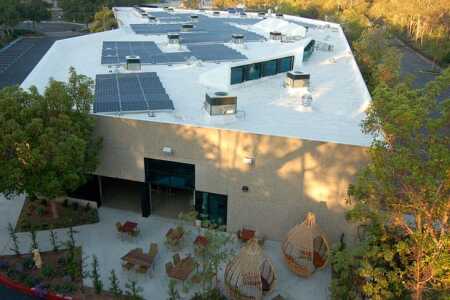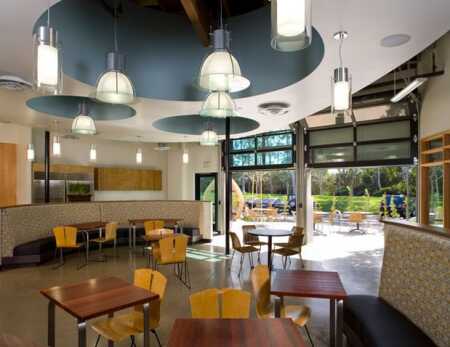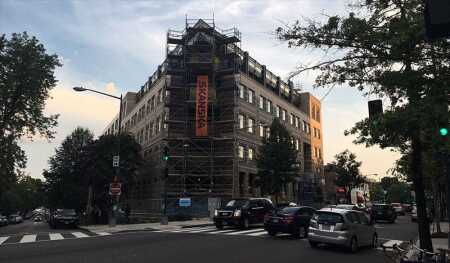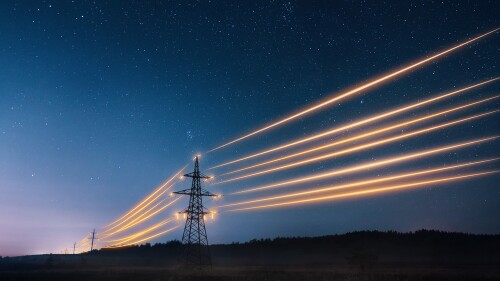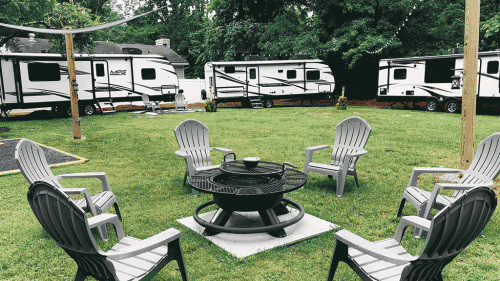In 2017, California passed the first net-zero building code in the United States (for new residential construction by 2020). New York City; Washington, D.C.; and other cities have made net-zero building commitments as well, including both new and existing buildings.
While a perception remains that achieving net zero is too costly for most residential and office development, a few pioneering development companies are figuring out how to deliver net-zero and net-zero-ready projects with a high net-present value at scale.
The Market Landscape
Net-zero-energy buildings have been an aspirational concept for architects and developers for some time. “Net-zero energy” and “net zero” commonly refer to a building that generates as much clean energy on site as it consumes. Buildings usually look to achieve net zero through deep investments in energy efficiency, coupled with an on-site source of clean, renewable energy. Washington, D.C., recently announced a goal to make all existing buildings net zero by 2032, and New York City recently announced plans to require retrofits to most existing buildings, to achieve a 50 percent reduction in energy consumption by 2030.
Leadership in Energy and Environmental Design (LEED) 4.0 and new building certification standards (Living Future, Passive House) also are pushing the bar on energy efficiency eligible for certification. In 2016, over 4,000 net-zero-energy buildings were completed, a 33 percent increase from the previous year. Today, there are thousands of net-zero projects covering all asset classes in the development pipeline.
Making Net Zero Affordable and Standard for New Home Construction
Meritage was one of the first homebuilders to pursue net-zero homes at scale, and is currently the leading major homebuilder developing “ZNE-ready” homes. Early on, the company made a commitment to energy efficiency and sustainability, and worked to drive the Energy Star homes program into their development, operations, and marketing efforts. According to C.R. Herro, vice president of environmental affairs at Meritage, “we didn’t want our homes to be seen as a commodity, and we felt that energy efficiency and sustainability could be a market differentiator in our industry.”
Meritage was able to achieve net-zero-ready homes using its streamlined manufacturing operations and its economies of scale. To achieve net zero, Meritage starts with energy efficiency: every home has high-efficiency heating, cooling, and lighting technology incorporated into the design. Each house is super-insulated, and includes high-efficiency windows and doors to fight heat loss in winter and heat gain in summer. To achieve net zero, customers can meet their (already low) utility expenses with a relatively modest on-site renewable energy system (one panel per 200 square feet [19 sq m], or a ten- to 15-panel system [2.5 kilowatts] for a 2,000-square-foot [186 sq m] home).
For customers, the return on investment starts on day one, since Meritage charges about the same per square foot for these houses as the company’s less energy-efficient peers charge for theirs. Meritage spends a little more on these homes, but believes that the additional cost is an investment in its marketing efforts—helping the homes sell faster and helping the company grow in an increasingly energy efficiency– and sustainability-conscious market.
Meritage also found that its net-zero-ready design helped “future-proof” its manufacturing model for increasingly rigid building codes: “California’s new construction codes and Title 24 had no disruptive impact,” says Herro. “Having our standards in place helped us avoid any disruption in manufacturing to retool for increasingly stringent regulations.”
Meritage delivers 10,000 energy-efficient homes to the market each year, and is helping homeowners who want to make these houses net zero find solar solutions that work for them. While only about 1 percent of homeowners opt for enough solar to make their homes net-zero-energy structures on day one, all the homeowners have a base building that consumes 30 to 50 percent less energy per square foot than the average house built to code in the United States.
Bringing “Flex Space” and Retrofits to Net Zero
Net-zero homes are the first building product being built to achieve net zero at scale, but leading companies are proving that net zero can deliver value in any building type. In 2008, DPR Construction’s San Diego office began working to make its 24,000-square-foot (2,200 sq m), multitenant, tilt-up concrete building more energy efficient. With a goal of cutting energy consumption to 50 percent below LEED (version 3), DPR started with heating and cooling. By making its north- and south-facing office windows operable and installing operable roof monitors connected to the building management system, DPR was able to use “passive ventilation” for up to 20 percent of the year (i.e., no heating or cooling was required). DPR also installed occupancy controls and sensors for its lighting and HVAC—heat pumps connected to the building only provided light, heat, air conditioning, and additional ventilation when there were people around to benefit from it. To reduce lighting energy use, the facility installed light-emitting diodes (LEDs), maximized the use of daylighting (so all lights often are off completely), and installed efficient skylights, which allowed them to reduce lighting density by 30 percent.
With all the energy-efficiency improvements, DPR was able to get the building’s energy efficiency to 65 percent below LEED 3.0 prerequisites (about 14 kBTUs per square foot). This saved the company about $22,000 in energy costs per year versus the estimated pre-retrofit energy use of the space. DPR installed a 64-kilowatt solar system that has actually made the building “net-positive,” generating 14 percent more energy than the building consumes each year. The building sells the rest of the electricity back to the grid, and, along with paying no energy bills, gets a check from San Diego Gas & Electric every month to buy its surplus energy.
When asked why they decided to pursue net zero, Landry Watson, the sustainability manager, replied: “To see if it could be done.” The sustainability-focused construction company wanted to be able to offer customers a pathway to net zero that was economical, so they tested low-cost efficiency concepts on themselves. DPR used off-the-shelf technology, rehabilitated an aging light-industrial building that likely would have otherwise been torn down, and completed the retrofit with a reasonable payback and an annual return on investment (ROI) exceeding 10 percent. The building (appraised before and after the net-zero upgrade) also increased its asset value by $3 million post-retrofit.
As a net-zero pioneer, Watson notes that “if we were building now, we would do peak demand management and energy storage. We would also expand LED usage and LED controls, whose price has come down dramatically in the last five years.” DPR is integrating these new and newly cost-effective technologies into the firm’s energy-efficient and net-zero projects for clients.
Major Renovations Targeting Zero Net Energy
Washington, D.C., will soon get its first multitenant, gut-rehab, net-zero office building. The American Geophysical Union (AGU) project, led by MGAC, Hickok Cole Architects, Interface Engineering, Skanska, and Stratacomm, is striving to relaunch the nonprofit organization’s 84,000-square-foot (7,800 sq m) headquarters to be net zero, using an array of technologies to make the building both super-efficient and innovatively renewable.
In pursuing net zero, the AGU’s board of directors decided to take on the challenge of renovating its headquarters to become, in the words of Christine McEntee, CEO and executive director for the AGU, “a living representation of AGU’s mission, science, and purpose.” She says, “We challenged ourselves to not only showcase scientific advancement through innovative sustainability technology, but to embody the spirit and values of scientific discovery throughout the process.” As a result, the building would be able to show how to achieve net zero and also demonstrate the impact that the AGU’s members’ work has on the world.
To achieve net zero, the AGU design and construction team used four key engineering principles: reduction, reclamation, absorption, and generation. From these four principles came 24 major energy efficiency and energy generation strategies, working together to get the buildings’ energy consumption to a level that could be offset with on-site renewable energy sources.
Efficiency strategies for the building include off-the-shelf technology like enhanced insulation, radiant ceiling cooling, and LED lighting, but also some new technologies and applications. The building’s windows will be triple-paned, high-efficiency windows with electro-chromatic dynamic glazing—reducing solar heat gain by self-tinting based on the level of sunlight hitting the building. The office lighting will be on a direct current system, avoiding energy efficiency losses associated with AC-to-DC conversion and allowing the building’s solar array to directly power the lighting. The AGU building will also use hydroponic phytoremediation to create a “living wall.” This large planting installation will help reduce heat loss in winter and absorb some heat gain in summer, and will also help purify indoor air (which, in turn, can reduce the need for extra ventilation).
The AGU net-zero retrofit will include some familiar and some new sources of renewable energy. On the roof, the AGU facility will have approximately 719 solar panels—enough to meet 100 percent of the building’s energy needs in conjunction with the other net-zero design strategies. The building is also tapping into the sewer—a new source of “renewable” energy that allows the AGU to capture heat and cooling from the municipal sewer system to reduce the energy used by the building’s chiller, and eliminate the need for a cooling tower on the roof.
Financing
A growing set of market incentives also may drive more builders and owners toward net zero. In residential development, Fannie Mae offers a 0.25 percent mortgage interest reduction for refinancing with its “green mortgage” product. Nearly half of U.S. states now offer some incentives for on-site renewable energy generation (in addition to the 30 percent Federal Investment Tax Credit), and several utilities are still offering significant rebates for LED lighting, high-efficiency insulation, and advanced building controls. At the same time, cities and states are passing more stringent building codes, and in one case (California) actually requiring net zero for new home construction by 2020. This growing set of regulations and incentives will continue to help improve the business case for building to (and retrofitting for) net zero.



